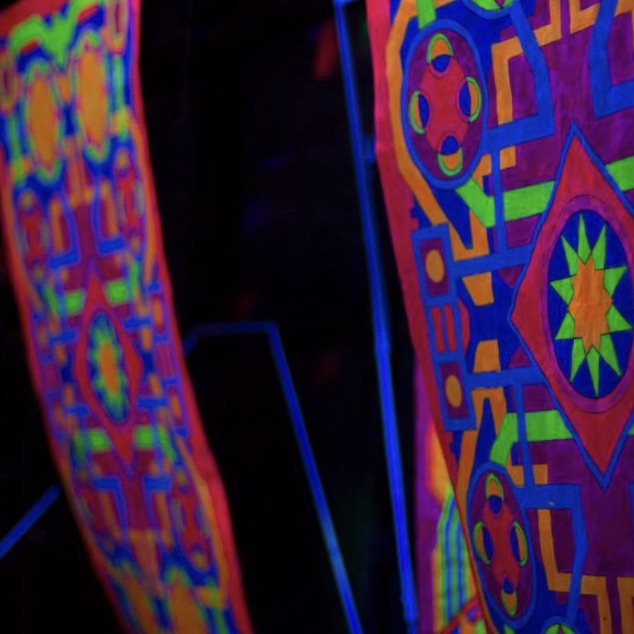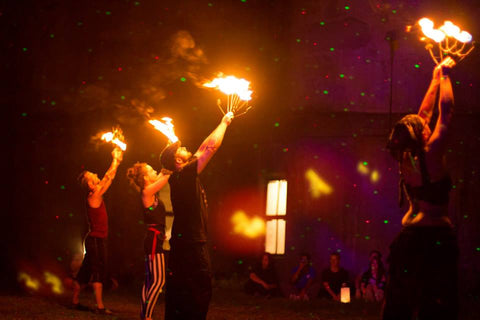Bringing the City of Light to Life at Night: ELAB City of Night, 2014
For years, the grain silos — huge concrete storage containers — in the Old First Ward have towered over Buffalo, many left unused after a bulk of industry left the area. Recently, however, a huge movement to reuse these historic structures has taken hold of the city’s residents. “Silo City,” the name given to three of the historic grain elevators owned by Mr. Rick Smith, has been connecting the industrial spaces to the community through a number of creative endeavors. August 17 of last summer, 13,000 people came to Silo City to experience the second year of a multi-dimensional pop-up art event: City of Night. Organized by the Emerging Leaders in the Arts Buffalo (ELAB), which is a branch of the national organization, Americans for the Arts, City of Night showcases installation artists, musicians and performance artists, and also capitalizes on community involvement while giving visitors the chance to explore the mammoth structures forever tied to Buffalo’s history and identity. The 2014 City of Night is tonight, June 28. The free and public event will take over Marine A, the two elevators built by the Abell family in 1925, which sits on the easternmost side of the peninsula. The Buffalo chapter of Americans for the Arts was founded in 2010. After a slightly bumpy start, which involved the group’s organizer relocating to another state, the remaining members (who self-identify as artists first, administrators second) decided to proceed in their mission. ELAB’s first big project, conceptualized by Marissa Lehner and Marcus L. Wise, was the Grant-Amherst Street mural. Painted by members of ELAB and people of the community, the mural is located in Black Rock, a neighborhood of Buffalo, right down the street from 464 Gallery (Mr. Wise’s gallery). ELAB hosts monthly art labs, where a featured artist presents his or her work and ideas, and artists can bring work, either in-progress or finished, for a multi-disciplinary critique. ELAB also began throwing “Big Ass Parties,” events where community members gather and contribute to a work of art over the course of the party. City of Night is the biggest “Big Ass Party,” but realizing the name might need to be remarketed, ELAB echoed the title of Lauren Belfer’s novel, “City of Light,” which is set in 1901-era Buffalo. ELAB members toured the grain silos and fell in love with the industrial beauty. Vice President Dana Saylor, who has been involved in preservationist movements in Buffalo, had the idea of holding an event in Silo City, and is now the Event Coordinator of City of Night. After months of planning, the day of the event came — that first time, it poured. Nevertheless, 7,000 people turned out. In 2013, attendance skyrocketed to 13,000. This year they expect the same turnout, if not more. Tara B. Sasiadek, the current President of ELAB, recalled having to re-draw a chalk drawing that had been washed away in the rain during the night before the inaugural event. “I got there that morning, and Melissa Lehner was squeegeeing out the grain elevators by hand. It was amazing and kind of terrifying.” It was just one example of the difficulty in planning and executing large-scale events in non-traditional places. Yet, the unpredictability is part of the magic, and artists adapt to install artwork with consideration to their surroundings. “You’re used to putting things on walls,” Ms. Sasiadek tells us, “and suddenly you’re engaging with this site that has history. The industrial set-up is so looming and gorgeous, but it also overpowers almost anything visual that you put in it. There’s no competing with it.” Instead, you have to work with the space; you need to create an experience. Ms. Sasiadek tells us about one of last year’s installations: Artist and ELAB member Kisha Patterson-Tanski placed a ring of fans, pointing up, in one of the silo shafts (standing over 100 feet high). Visitors pushed balloons into the space, and if done correctly the balloons floated right up to the ceiling and hovered there. “It was this sublime, kind of goofy, use of the space,” Ms. Sasiadek adds, “During the day and during the night changed what it looked like, but people [were] engaged with the work and with the space.” Discovering spaces unique to the city is a big part of City of Night. Silo City is bustling with activity, and things aren’t slowing down there. There are plans for a rock climbing facility built on the exterior and inside one of the elevators, as well as a 22-foot tall stainless steel, sustainable beehive built to house a population of bees that were found inside one of the elevators. With Silo City attracting more ideas and preservationists, some at ELAB feel the time is right to uncover another underutilized space for City of Night. Ms. Sasiadek elaborates: “We think of it as long-term sculpting: the group of us together are making the space accessible for other artists and also for Buffalo. We’re awakening places of the city that people don’t really think of as beautiful or useable or exploreable. Over time, Silo City will have so much going on there that it will be kind of redundant for us to open it up for exploration. Then we’ll want to find another place. We’re always throwing around ideas for places. Buffalo is so full of these abandoned treasures and industrial sites. We’re trying to find the places that don’t already have the interest of revival.” Going back to the community of artists, ELAB has another idea in the works, a lending library for artists. Ms. Sasiadek touches on one of the difficulties of being in a creative field, the reason that support for the arts is necessary: “You wouldn’t invite a plumber to your house and say, ‘Please fix my toilet for free,’ yet I’m constantly asked to donate paintings — others are asked to write or sing or perform or dance for free. We don’t have a burgeoning community of support monetarily, but we have a fantastic community of artists of all kinds. People in Buffalo are generous with their time and advice. We want to pass that on to our members.” ELABrary, as it is called, will not “be a space to show work, but a space to make work;” there are other venues in the community for showcasing work. Instead, ELAB will give artists the shared knowledge, the raw materials and the networking to get projects done. ELAB’s projects show what happens when knowledge meets collaboration and passion — creativity and public interest run rampant, in a very good way.


Leave a comment